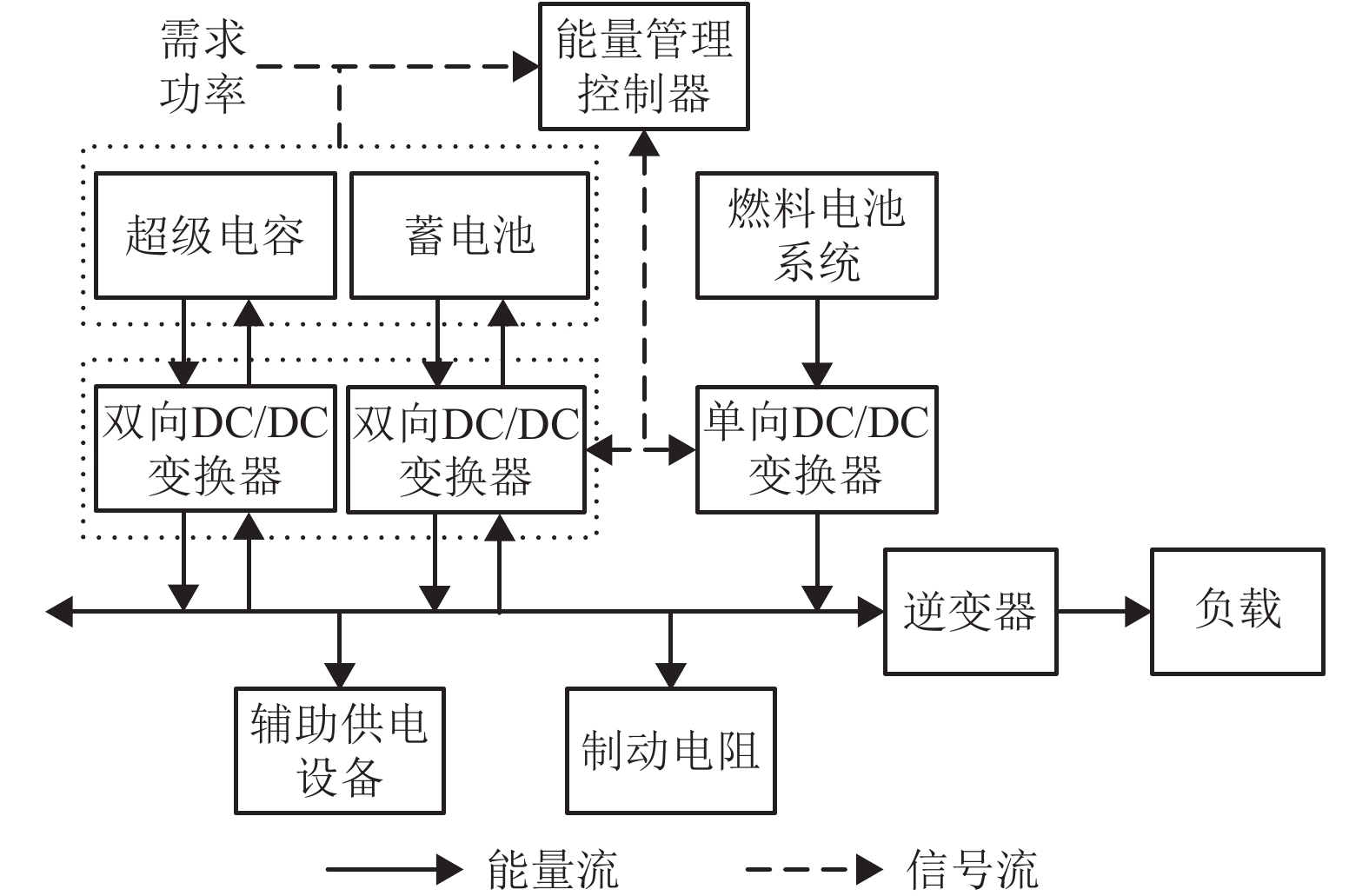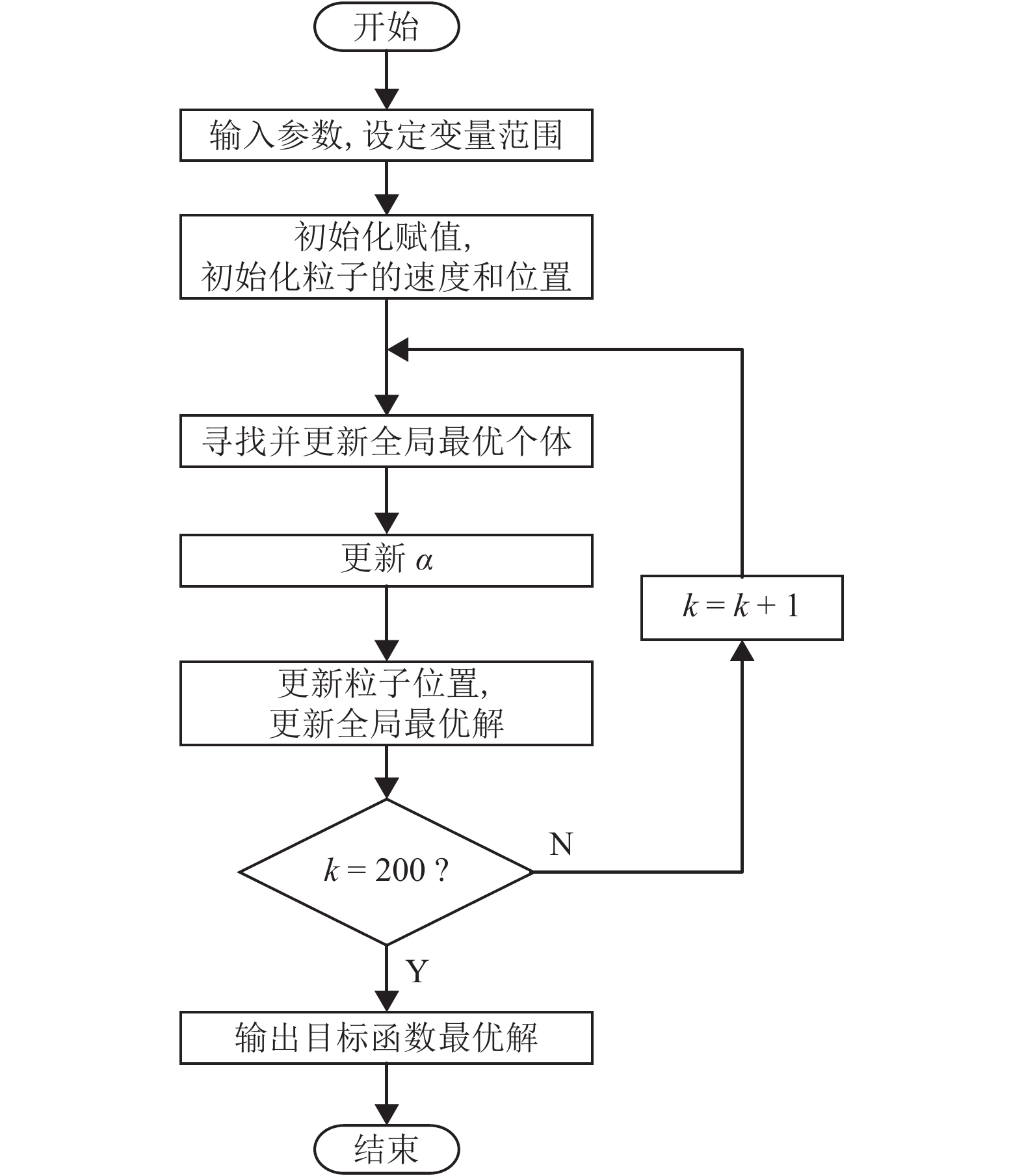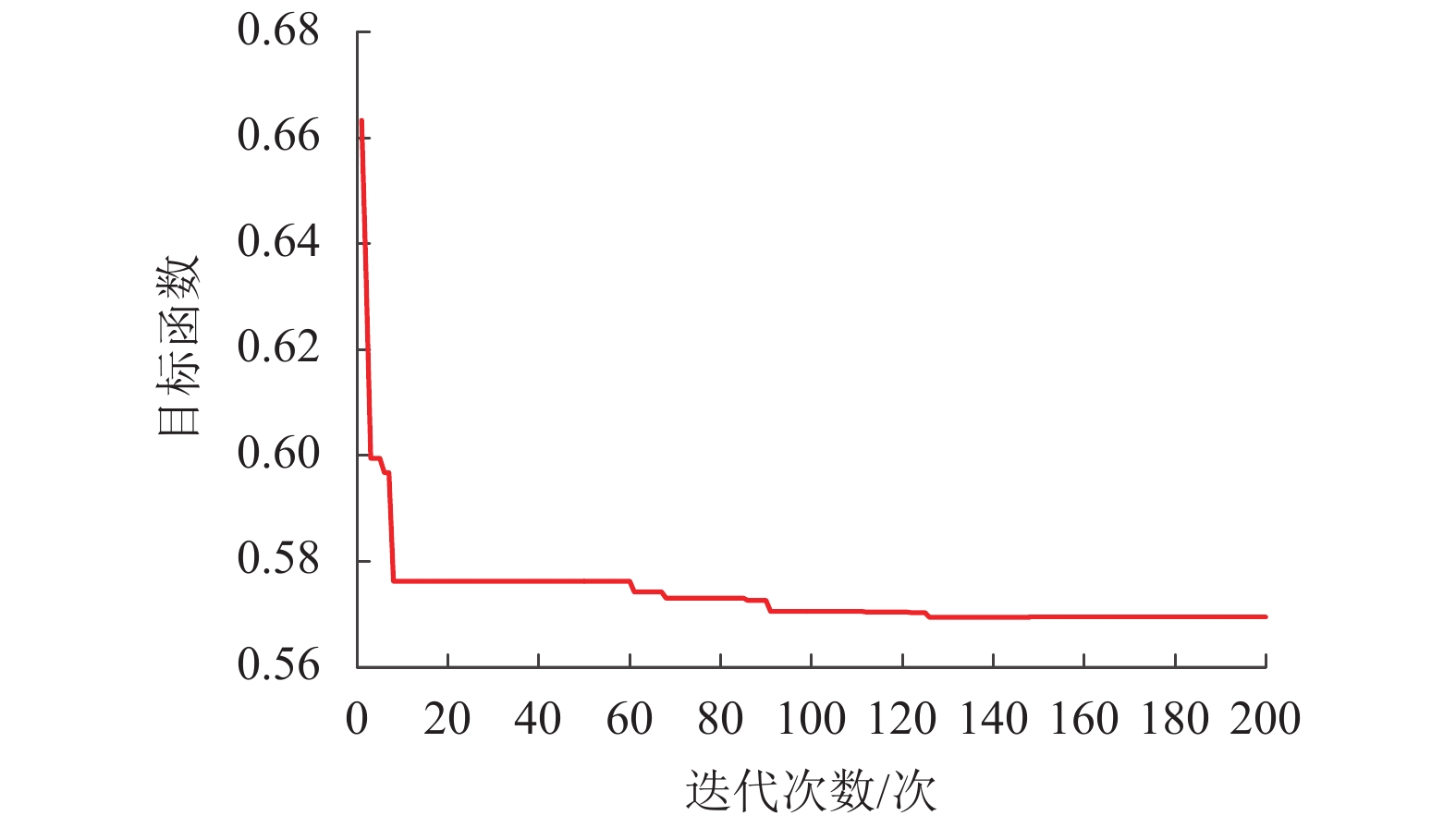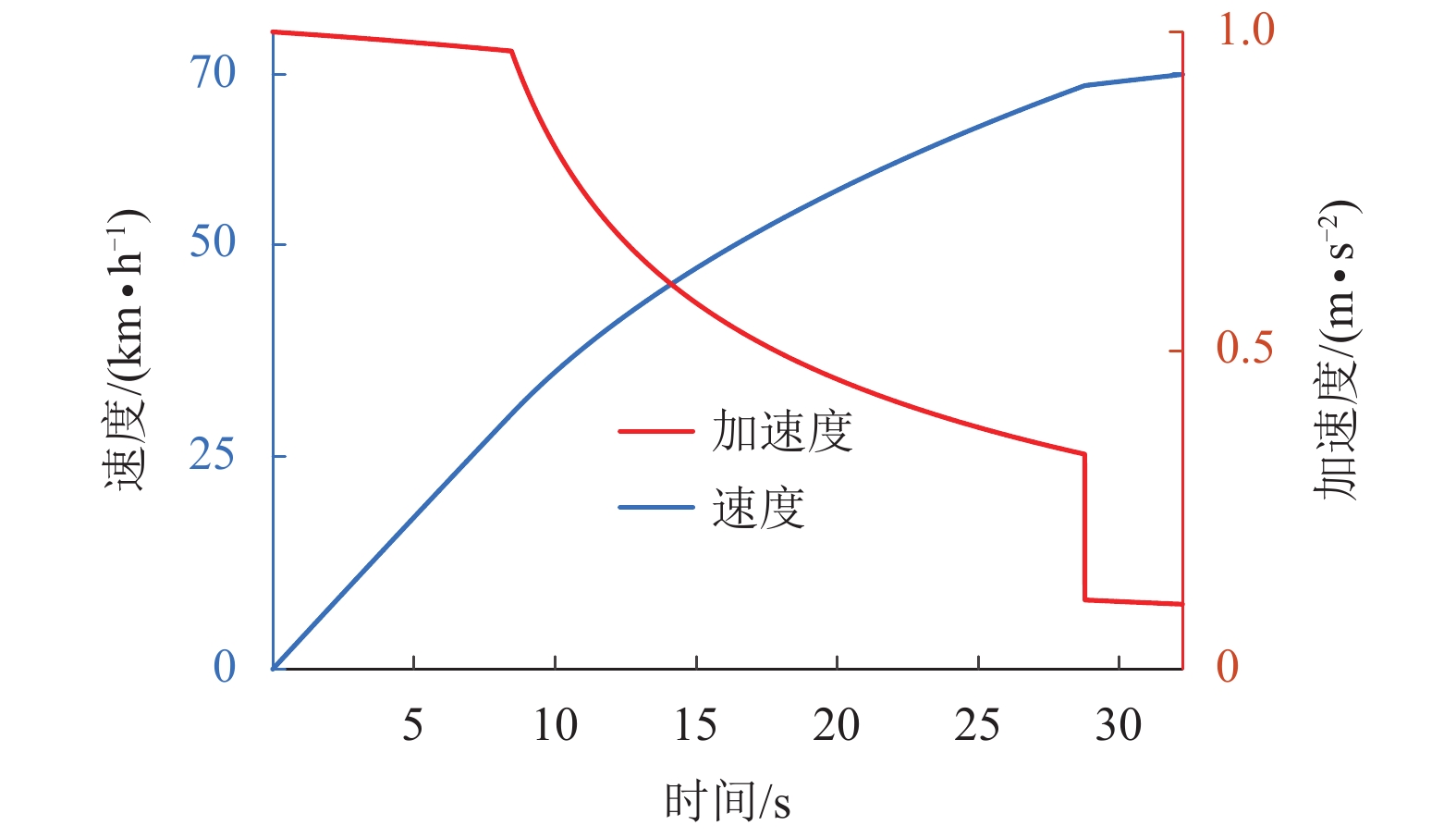Parameter Matching and Multi-objective Optimization of Fuel Cell Hybrid System
-
摘要: 在满足机车动力性能需求的条件下,运用参数匹配方法对燃料电池系统的重量、体积指标进行了优化. 首先,搭建了机车动力学模型,针对列车运行的加速启动、匀速爬坡、最大时速运行3种关键工况,分别得到3个需求功率峰值;其次,基于传统方法,以最大需求功率峰值为目标,分析了超级电容-动力电池配比;然后,在传统方法基础上,采用改进粒子群算法(improved particle swarm optimization,IPSO),进行了基于系统重量和体积的多目标优化参数匹配计算,得到了最优解;最后,对传统方法和多目标优化方法进行了对比分析. 研究结果表明:两种方法均能满足列车动力需求;采用多目标优化方法,为同型燃料电池混合动力有轨电车配置2套150 kW燃料电池,124个超级电容(48 V,165 F)和337个动力电池(3.7 V,9 A•h). 车辆经32.24 s加速可达时速70 km/h,最大爬坡能力为85.5‰,持续爬坡能力为732.5 m;相比较传统方法,重量和体积优化率分别达到83.075%和86.696%.
-
关键词:
- 燃料电池混合动力有轨电车 /
- 混合动力系统 /
- 参数匹配 /
- 多目标优化 /
- 改进粒子群算法
Abstract: With the requirements of tram dynamic performance fulfilled, the weight and volume of the fuel cell hybrid system are optimized by the parameter matching method. Firstly, the vehicle dynamic model is built, and three peak powers are obtained, which corresponds three operational modes of trams including startup acceleration, climbing with uniform speeds and maximum speed operation. Secondly, based on the traditional method, the maximum peak power is set as an objective, and the supercapacitor-battery propotion is analyzed. Then, based on the traditional method, the improved particle swarm optimization (IPSO) is used to calculate the multi-objective optimal parameters in terms of the weight and volume of the system. Finally, the traditional method and multi-objective optimization method are compared and analyzed. The results show that both methods can meet the tram power demand. According to the multi-objective optimization method, the fuel cell hybrid tram is configured with two sets of 150 kW fuel cells, 124 supercapacitors (48 V, 165 F) and 337 power batteries (3.7 V, 9 A•h) . The tram can accelerate up to 70 km/h in 32.24 s, the maximum climbing capacity is 85.5‰, and the continuous climbing ability is 732.5 m. Compared with the traditional method, the optimization rate of its weight and volume reaches to 83.075% and 86.696% respectively. -
表 1 燃料电池主要参数数据
Table 1. Main parameters of fuel cell
参数 取值 总功率/kW 150 工作电压/V 465~730 最大电流/A 300 燃料 氢气 氧化剂 空气 电池重量/kg 404 电池尺寸 1 530 mm × 871 mm × 495 mm 表 2 超级电容主要参数数据
Table 2. Main parameters of supercapacitor
参数 取值 额定容量/F 165 额定电压/V 48 最低工作电压/V 24 可用比功率/(W•kg−1) 3 300 电容重量/kg 13.9 电容尺寸 418 mm × 194 mm × 179 mm 最大持续电流/A 100 表 3 动力电池主要参数数据
Table 3. Main parameters of battery
参数 取值 额定电压/V 3.7 额定容量/(A•h) 10 电池内阻/Ω 1.5 放电截止电压/V 2 最大充电电压/V 4.1 最大放电电流/(A•h) 120 电池重量/kg 0.3 电池尺寸 203 mm × 127 mm × 6 mm 表 4 目标车辆动力性能指标
Table 4. Dynamic performance index of the tram in this study
参数 取值 车重/t 48.6 载客/人 267 (60 kg/人) 载重/t 16.02 最高时速/(km•h−1) 70 运营速度(km•h−1) 30 最大加速度(m•s−2) 1 辅变功率/kW 20 最大爬坡角度/‰ 70 惯性系数Aω 2.910 0 惯性系数Bω 0.091 0 惯性系数Cω 0.000 7 回转质量系数 0.100 0 表 5 两设计方案结果对比
Table 5. Comparison of the two design methods
参数 传统方法 多目标优化方法 燃料电池数量/套 2 2 超级电容数量/个 160 124 动力电池数量/个 668 337 系统总质量/kg 6 939.90 5 765.33 系统总体积/m3 7.54 6.54 -
侯明,衣宝廉. 燃料电池技术发展现状与展望[J]. 电化学,2011,18(1): 1-13.HOU Ming, YI Baolian. Progress and perspective of fuel cell technology[J]. Journal of Electrochemistry, 2011, 18(1): 1-13. 陈维荣,钱清泉,李奇. 燃料电池混合动力列车的研究现状与发展趋势[J]. 西南交通大学学报,2009,44(1): 1-6. doi: 10.3969/j.issn.0258-2724.2009.01.001CHEN Weirong, QIAN Qingquan, LI Qi. Investigation status and development trend of hybrid power train based on fuel cell[J]. Journal of Southwest Jiaotong University, 2009, 44(1): 1-6. doi: 10.3969/j.issn.0258-2724.2009.01.001 陈维荣,刘嘉蔚,郭爱,等. 14.4 kW PEMFC电堆单体电压均衡性实验研究[J]. 西南交通大学学报,2017,52(3): 429-438. doi: 10.3969/j.issn.0258-2724.2017.03.001CHEN Weirong, LIU Jiawei, GUO Ai, et al. Experimental study on voltage uniformity of 14.4 kW PEMFC stack single cell[J]. Journal of Southwest Jiaotong University, 2017, 52(3): 429-438. doi: 10.3969/j.issn.0258-2724.2017.03.001 薛美根,杨立峰,程杰. 现代有轨电车主要特征与国内外发展研究[J]. 城市交通,2008,6(6): 87-91.XUE Meigen, YANG Lifeng, CHENG Jie. Modern trams:characteristics & development both at home and abroad[J]. Urban Transport of China, 2008, 6(6): 87-91. 陈维荣,卜庆元,刘志祥,等. 燃料电池混合动力有轨电车动力系统设计[J]. 西南交通大学学报,2016,51(3): 430-436. doi: 10.3969/j.issn.0258-2724.2016.03.003CHEN Weirong, BU Qingyuan, LIU Zhixiang, et al. Power system design for a fuel cell hybrid power tram[J]. Journal of Southwest Jiaotong University, 2016, 51(3): 430-436. doi: 10.3969/j.issn.0258-2724.2016.03.003 陈维荣,张国瑞,孟翔,等. 燃料电池混合动力有轨电车动力性分析与设计[J]. 西南交通大学学报,2017,52(1): 1-8. doi: 10.3969/j.issn.0258-2724.2017.01.001CHEN Weirong, ZHANG Guorui, MENG Xiang, et al. Dynamic performance analysis and design of fuel cell hybrid locomotive[J]. Journal of Southwest Jiaotong University, 2017, 52(1): 1-8. doi: 10.3969/j.issn.0258-2724.2017.01.001 CHEN Weirong, PENG Fei, LIU Zhixiang, et al. System integration of China’s first PEMFC locomotive[J]. Journal of Modern Transportation, 2013, 21(3): 163-168. doi: 10.1007/s40534-013-0020-0 中华人民共和国铁道部. 列车牵引计算规程: TB/T 1407—1998[S]. 北京: 中国标准出版社, 1998. 郭斌,秦孔建,卢青春,等. 燃料电池混合动力系统构型和控制方法研究[J]. 科技汽车,2006(3): 10-13.GUO Bin, QIN Kongjian, LU Qingchun, et al. Study on configuration and control method of the hybrid power system of fuel cell[J]. Vehicle Technology, 2006(3): 10-13. 曹秉刚,曹建波,李军伟,等. 超级电容在电动车中的应用研究[J]. 西安交通大学学报,2008,42(11): 1317-1322. doi: 10.3321/j.issn:0253-987X.2008.11.001CAO Binggang, CAO Jiangbo, LI Junwei, et al. Ultracapacitor with applications to electric vehicle[J]. Journal of Xi’an Jiaotong University, 2008, 42(11): 1317-1322. doi: 10.3321/j.issn:0253-987X.2008.11.001 刘晓臣. 超级电容器工作原理及应用[J]. 电子产品可靠性,2012,30(1): 111-114.LIU Xiaochen. Principle and application of super capacitors[J]. Electronic Production Reliability and Environment Testing, 2012, 30(1): 111-114. 宫学庚,齐铂金,刘有兵,等. 电动汽车动力电池模型和SOC估算策略[J]. 电源技术,2004,28(10): 633-636. doi: 10.3969/j.issn.1002-087X.2004.10.011GONG Xuegeng, QI Bojin, LIU Youbing, et al. Research on the model and estimated strategy of SOC for drain battery of electric vehicle[J]. Chinese Journal of Power Sources, 2004, 28(10): 633-636. doi: 10.3969/j.issn.1002-087X.2004.10.011 蒋伊琳,张芳园. 基于自然选择粒子群的时钟同步算法[J]. 西南交通大学学报,2017,52(3): 593-599. doi: 10.3969/j.issn.0258-2724.2017.03.021JIANG Yilin, ZHANG Fangyuan. Clock synchronization algorithm based on natural selection particle swarm[J]. Journal of Southwest Jiaotong University, 2017, 52(3): 593-599. doi: 10.3969/j.issn.0258-2724.2017.03.021 -





 下载:
下载:





